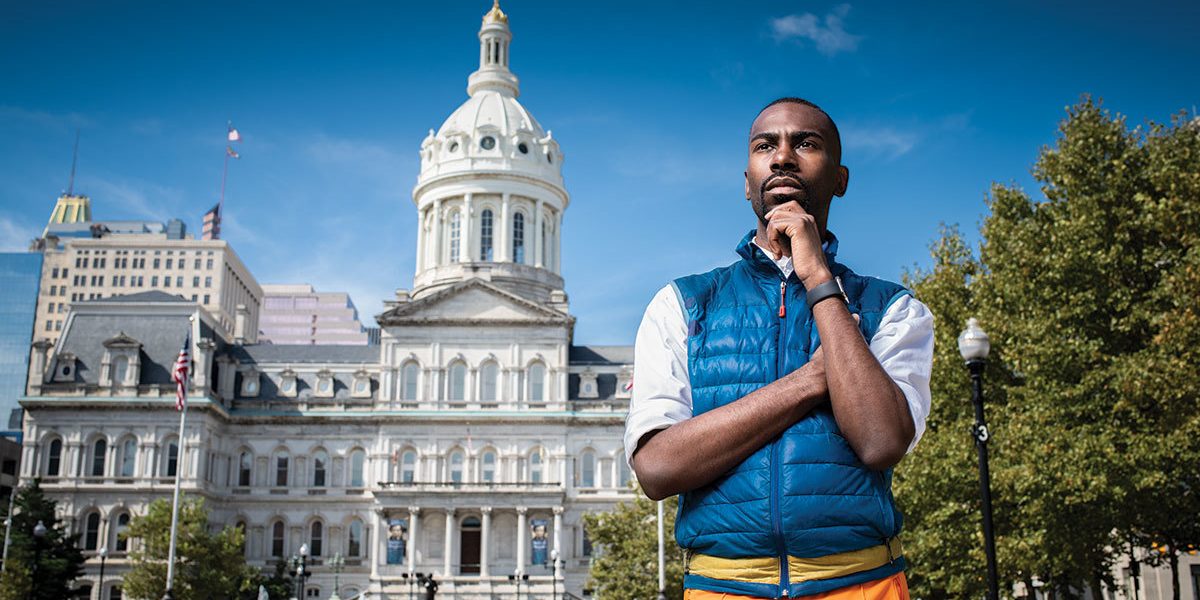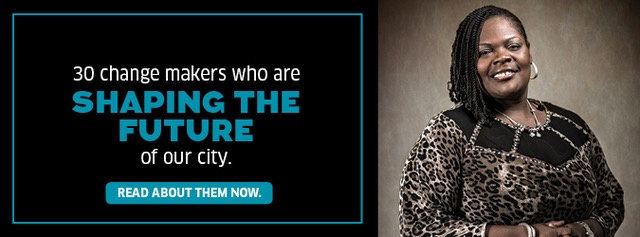History & Politics
Vested Interest
DeRay Mckesson is a nationally recognized civil rights activist. Will he become a leader in Baltimore?
DeRay Mckesson is tired. He tweeted he’d been “cursed to sit next to the drunk man” flying back from the West Coast as he wrapped up a five-week, 22-stop, cross-country book tour. Arriving at Ida B’s Table for a morning interview and photo shoot, the 33-year-old activist is punctual and polite, but his distinctive, high-pitched voice is softer than usual. Nonetheless, he’s ready to discuss his role in the Black Lives Matter movement and his recent call-to-action memoir, On the Other Side of Freedom: The Case for Hope. Brief recap: Mckesson garnered national attention live-tweeting the Ferguson, Missouri, marches following the killing of Michael Brown Jr. by a white police officer, and he checked in at No. 11 (along with fellow protestor Johnetta Elzie) on Fortune’s list of the “World’s Greatest Leaders” in 2015.
Jet-lagged or not, Mckesson cogently breaks down the structural racism that plagues cities such as Ferguson and Baltimore, as well as the foundational ideas that built and sustained that inequality. That preternatural ability to communicate—with composure and conciseness—is how the Baltimore native became an overnight cable news go-to.
“When we think about white privilege, it is the recognition that people benefit from things that they personally did not work for,” he begins, addressing a subject covered on his book tours. “When we think about white supremacy, it is the idea that white is better, that white is the norm, is the standard, that it is more worthy. And then, we think about ‘whiteness,’ and it is the culture that idea births.”
On the road, Mckesson was interviewed by the likes of MC Hammer, former Obama speechwriter Jon Favreau, and The Daily Show’s Trevor Noah. He has a million-plus followers on Twitter, has hosted celebrities from John Legend to Katy Perry on his weekly show, Pod Save the People, and he gets invited to parties by Beyoncé. But here’s the weird thing: While Mckesson was born here and lives here, he draws only a small crowd to his book signing later tonight at Baltimore Soundstage.
“I don’t mean this in a good or bad way, I just don’t come across him,” says Sean Yoes, Baltimore AFRO editor and author of Baltimore After Freddie Gray: Real Stories from One of America’s Great Imperiled Cities. He may be a national civil rights figure, but Mckesson is not a conspicuous presence in Baltimore two years after his bid for the city’s highest office. “Maybe I’m just in my own lane—I hadn’t thought about him in months, at least,” Yoes continues. “He’s kind of in a no-man’s land here.”
The protests in Ferguson after Michael Brown’s death began a little more than four years ago, but it is easy to forget the timeline, the details, and the next 400 days of activism that helped set the stage for the uprising in Baltimore following the death of Freddie Gray. Several days after officer Darren Wilson’s shooting of Brown in August 2014, Mckesson, then a 29-year-old Minneapolis public school administrator, headed to Missouri to see the unfolding situation for himself. He live-tweeted his mundane drive to his then-modest 800 followers while also seeking a sofa to sleep on once he reached Ferguson. The second night he was there, police tear-gassed demonstrators. “That was the moment I became a protestor,” he says.
In collaboration with Elzie and Brittany Packnett, both St. Louis-area natives, Mckesson took to social media to document the confrontations with the Ferguson police department’s militarized response. They also used their online platforms to launch the Ferguson Protestor Newsletter, which became both a resource for—and an alternative to—the establishment media, which they saw misrepresenting the protests as violent.
Identifiable in his ubiquitous royal blue Patagonia vest, which he basically has not taken it off since, Mckesson became the most recognizable face of the Black Lives Matter movement. In fact, the vest remains so intertwined with his political brand that it has its own Twitter handle.
After Ferguson, Mckesson joined similar protests in Baton Rouge, Louisiana, following the death of Alton Sterling; New York following the death of Eric Garner; North Charleston, South Carolina, following the shooting of Walter Scott; and Baltimore following the death of Freddie Gray. (In one memorable interview here, he repeatedly pushed back against CNN’s Wolf Blitzer, who tried to get a patient Mckesson to condemn the behavior of protestors. “You are suggesting this idea that broken windows are worse than broken spines,” Mckesson responded.) Since then, along with Packnett and policy analyst and data scientist Samuel Sinyangwe, Mckesson helped create the police reform initiative Campaign Zero and its associated website, mappingpoliceviolence.org, which tracks the people killed by police in the U.S. “The numbers are flat, not down at all,” he notes, with a mixture of frustration and disbelief.
As he chronicles in some of the best chapters of his book, Mckesson was born in West Baltimore, later moving with his father, a recovering drug addict, and his sister to Catonsville. It was in Catonsville, he says, that he first became aware of poverty and the inequity in education.
After college at Bowdoin in Maine, he taught in New York City through Teach for America before returning to Baltimore for three years to work for a nonprofit after-school educational initiative and the city school system. He then spent 16 months in Minneapolis as senior director of human capital for their school system before leaving for Ferguson. He has received death threats and has been sued by police officers. In turn, he has sued Fox News and commentator Jeanine Pirro for alleging he incited violence. Along the way, the Obama White House invited him to a policy discussion, and he joined the speaking roster at Creative Artists Agency, whose clients include Joe Biden and Will Smith. Oh, and he gave commencement speeches at The New School and the Maryland Institute College of Art. In other words, it has been a roller coaster.
“You are suggesting this idea that broken windows are worse than broken spines.”
As the threats and lawsuits attest, Mckesson has also become a lightning rod. Much of the fire directed his way derives from mere hate from the other side. But there has been—and remains—resentment and criticism among those who normally would be considered allies. Broadly, the accusation is that he raced in front of cameras and put himself forward as a spokesman for a movement he did not begin.
Kaysonya Wise Whitehead, a Loyola University professor who teaches a course on the Black Lives Matter movement and hosts a current events program on WEAA, is not a Mckesson fan. “Black Lives Matter is a social movement, a civil rights movement, and it’s a slogan—it is something to stick on the bumper of car,” Whitehead says. “It’s all those things. But the people who created the hashtag and pushed it forward have been scrambling to get in front of it ever since. The fact that the white media rallies around someone does not make him or her a leader. Has DeRay been a leader on these issues locally? No, it’s The Algebra Project, Leaders of a Beautiful Struggle, Baltimore Bloc, Pleasant Hope Baptist Church, among many others, that’s been doing the work.”
Mckesson’s last-minute entry into the Baltimore mayoral race in 2016—an announcement made in coordination with The Washington Post, The New York Times, and The Guardian—gave detractors additional fuel.
“It’s one thing to be able to show up to an event in a major mainstream media moment,” Dayvon Love, public policy director for Leaders of a Beautiful Struggle, told Slate after Mckesson’s announcement. “It’s a different thing to get people from Baltimore to go to Annapolis for a hearing on police reform on a Tuesday at 1 in the afternoon.”
“It was opportunistic,” Anthony McCarthy, a former spokesman for the past three Baltimore mayors, says of Mckesson’s bid. “There was already one of the strongest fields in a long time.” That said, Mckesson did receive support from Morgan State professor Lawrence Brown, who is at work on a book about Baltimore’s history of segregation and housing discrimination. “What have those other establishment candidates accomplished?” Brown argues, suggesting an outsider is needed to bring real change to City Hall.
Mckesson, who received 2 percent of the vote, takes exception to the criticism. He highlights the year he spent opening and overseeing a West Baltimore after-school center with the nonprofit Higher Achievement and leadership roles when he was a Catonsville High School student with the city’s Safe & Sound Campaign and the grant-making nonprofit Youth As Resources. “For all this talk about ‘ending the gatekeepers,’ there are places where people’s identity is rooted in deciding who is and who isn’t able to do [activism] work, and Baltimore is one of those places,” he says.
This past election season, he stirred more controversy by endorsing fellow Teach for America alum J.D. Merrill, son-in-law to former Mayor Martin O’Malley, over longtime Baltimore civil rights leader Jill Carter for a seat in the state Senate (Carter won). Meanwhile, Mckesson says he doesn’t know if he’ll run for office again or how long he’ll stay in Baltimore. Current plans revolve around his national podcast and Campaign Zero, which he says will be publishing new data soon about police complaints and police union contracts.
Erin Hodge-Williams, former executive director of the nonprofit Higher Achievement, has known Mckesson since he was a teenage youth organizer. “He pours himself into everything he does,” Hodge-Williams says. “The traction he got [after Ferguson] surprised me, but I think the blue vest, for example, is ingenious. Is it branding? Yes,” she continues. “But I think it’s brilliant. Trump is on Twitter all the time stirring up nonsense. DeRay strategizes how to make his voice heard, too, but that’s because he wants to talk about policing and prison reform and social justice. He stays true to his message, and that makes all the difference in the world.”
Whether it makes a difference in Baltimore may be another matter.

